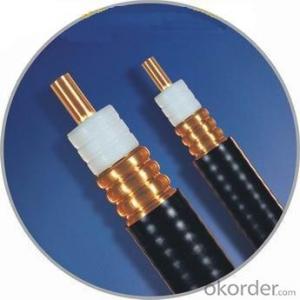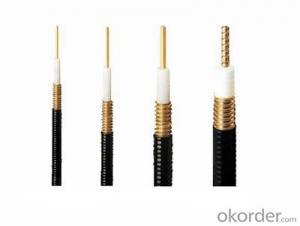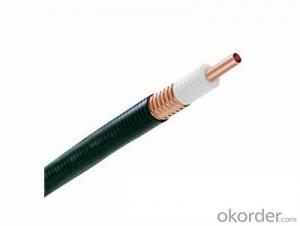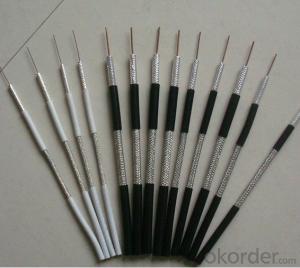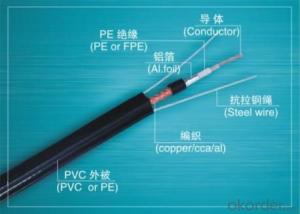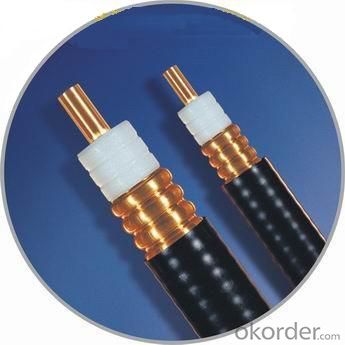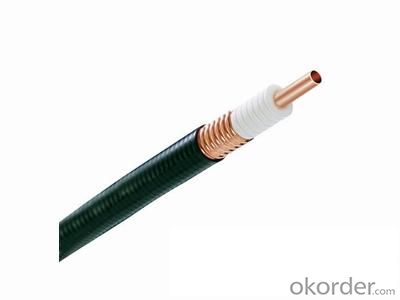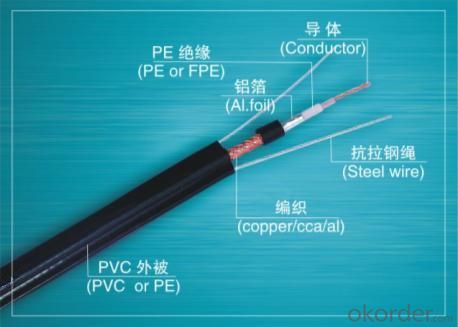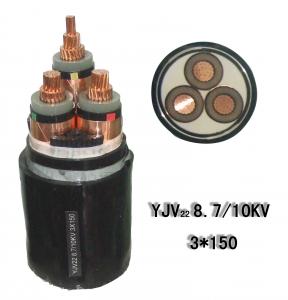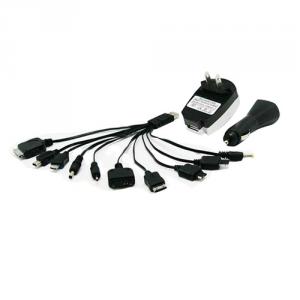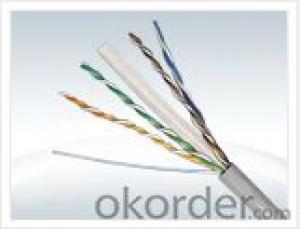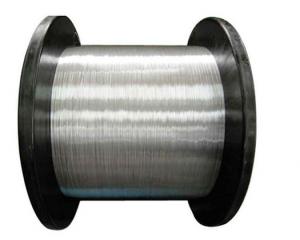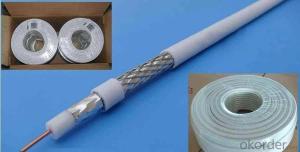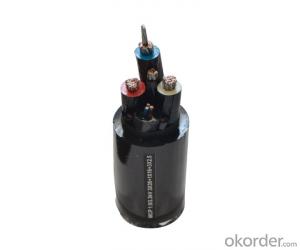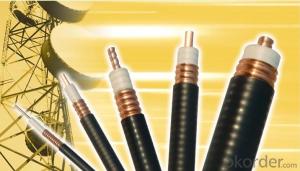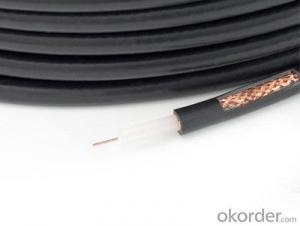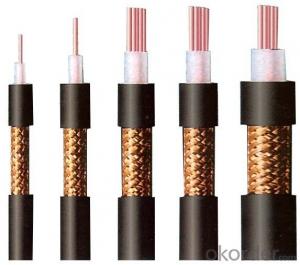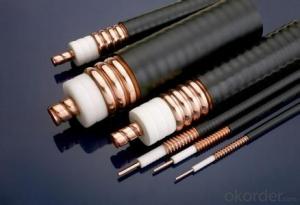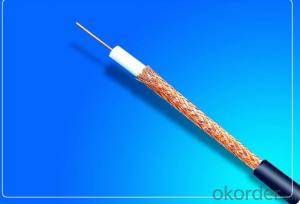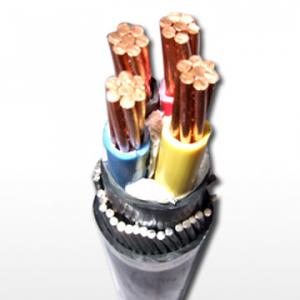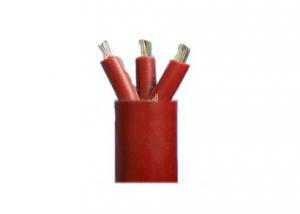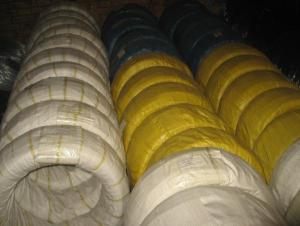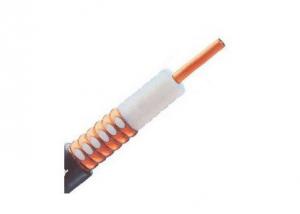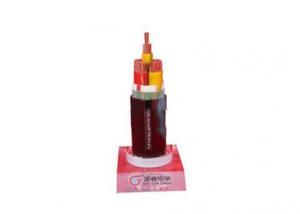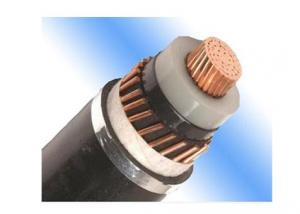Polyethylene(PE) insulated RF cable SYKV-75-5
- Loading Port:
- Shanghai
- Payment Terms:
- TT OR LC
- Min Order Qty:
- 100 m
- Supply Capability:
- 100000 m/month
OKorder Service Pledge
OKorder Financial Service
You Might Also Like
Product properties:
Uses: This product is applicable to shared antenna systems, closed circuit television system and other signal transmission, and such cable has the characteristics of small attenuation and strong anti-interference
SYV Solid polyethylene insulated RF cable:
Type | Cable structure parameters | |||||
Inner conductor | Insulation | Outer conductor | Jacket | |||
Structure elements/diameter | Outer diameter | Structure | Nominal thickness | Thinnest thickness | Outer diamete | |
SYV75-2 | 7/0.08 | 1.5±0.10 | Single braid layer | 0.43 | 0.30 | 2.9±0.10 |
SYV75-3 | 7/0.17 | 3.0±0.15 | Single braid layer | 0.66 | 0.45 | 5.0±0.25 |
SYV75-5-1 | 1/0.72 | 4.6±0.20 | Single braid layer | 0.90 | 0.60 | 7.1±0.30 |
SYV75-5-2 | 7/0.26 | 4.6±0.20 | Single braid layer | 0.90 | 0.60 | 7.1±0.30 |
SYV75-7 | 7/0.40 | 7.30±0.25 | Single braid layer | 1.0 | 0.70 | 10.2±0.30 |
SYV75-9 | 1/1.37 | 9.0±0.30 | Single braid layer | 1.2 | 0.80 | 12.4±0.40 |
SYV50-2-1 | 7/0.15 | 1.5±0.10 | Single braid layer | 0.43 | 0.30 | 2.9±0.10 |
SYV50-2-2 | 1/0.68 | 2.2±0.10 | Single braid layer | 0.56 | 0.40 | 4.0±0.20 |
SYV50-3 | 1/0.90 | 3.0±0.15 | Single braid layer | 0.66 | 0.45 | 5.0±0.25 |
SYV50-5-1 | 1/1.37 | 4.6±0.20 | Single braid layer | 0.90 | 0.60 | 7.0±0.30 |
SYV50-5-2 | 1/1.37 | 4.6±0.20 | Single braid layer | 0.90 | 0.60 | 7.8±0.30 |
SYV50-7-1 | 7/0.76 | 7.3±0.25 | Single braid layer | 1.0 | 0.70 | 10.2±0.30 |
SYV50-7-2 | 7/0.76 | 7.3±0.25 | Single braid layer | 1.0 | 0.70 | 11.2±0.30 |
SYKV vertical hole PE insulated RF cable::
Structure | Type | Inner conductor | Insulation outer diameter | Insulation resistance | Characteristic impedance | Capacitance | Attenuation Coefficient | Reference Weight | ||
50MHz | 200MHz | 800MHz | ||||||||
Vertical hole Insulation | SYKV-75-5 | 1/1.00 | 4.8 | 5000 | 75±3 | 60 | 5.3 | 10.8 | 22.9 | 50 |
SYKV-75-7 | 1/1.60 | 7.3 | 5000 | 75±3 | 60 | 3.4 | 7.1 | 15.2 | 95 | |
SYKV-75-9 | 1/2.00 | 9.0 | 5000 | 75±3 | 60 | 2.8 | 5.7 | 12.5 | 153 | |
- Q: can we install power 480 VAC and control 120 VAC cables,,, each one in different conduit but in parallel and adjacent ?also for two control cables ,,,, can they installed in one conduit ?
- It is a standard practiceto run power and control cables in different conduit but the basic criteria is voltage gradings.All cables upto 500volts can be laid in one conduit whether power or conrol.In case of high voltage cables, because of elecromagnetic inducion effect, different conduit is adopted.
- Q: I have a VOX Valvetronix amp and my idiot older brother has misplaced the the power cord to it. Where is the best place to find said replacement as well as a guitar jack to plug into the amp itself since that seems to be missing as well. Thanks!
- The power cable is just a standard plug. The one in the back of your computer will work. You can find replacements at drug stores, Radio Shack, hardware stores, Best Buy, and of course guitar stores. The instrument cable is a standard 1/4'' jack and the cable is shielded. This you can find at Radio Shack, a guitar store, or Best Buy. Make sure you get an 'instrument' cable. Speaker cable looks similar and will actually work but it's not shielded and you'll get electrical interference messing up your signal.
- Q: Big god speed to ~ ~ ~ ~ ~ ~ ~ ~ ~ ~ ~ ~ ~ ~ ~ much needed
- Yellow is the ground, the other two casually, mainly to see when you plug there is the line of fire, no effect.
- Q: Hey! I bought a new sound system for my truck including 4 new speakers, a sub, a 5-channel amp, and I'm running all new wiring. So far I've got the 3 RCA cables ran, along with the blue remote turn-on wire along the right side of my truck. I plan to run the Power wire down the left side and then to my amp.I've heard that you put the power wire and RCA cables on different sides, which is what I've done, but is it ok for my speaker wires to be run beside or close to the power wire(4-gauge fyi)?For example, the right side speaker wires wont be near it, but the left side speaker wires will be...Will this cause any weird noise from my speakers?I don't have the names/etc of all my gear right in front of me, but if u rly need it, I will quot;add detailsfor you! Thanks!!
- Well....That is determined by how colossal the amp is. An extension wire has either 2 or three wires inside of at someplace between sixteen and 12 gauge wire. You could twist the entire conductors together and be excellent up to about 40 amps with three 12 gauge wires. The quandary with amplifiers is current no longer voltage. The thicker the wire the more present it will handle. Most any wire you purchase is rated as a minimum 120V. Check what dimension fuse the amp requires, whether it is more than 30 to forty amps i would purchase the correct size single wire for the amp. Also, fuse the wire at the battery. Fire is just not our pal. :)
- Q: Can A bad battery or power cable cause a laptop to Blue Screen?Is there anyway to pinpoint the actual cause?
- BSOD errors are usually caused by driver problems. Try updating the computer's drivers. Try switching between the manufacturer's drivers and the drivers provided by Microsoft Update (assuming it is a Windows laptop). Overheating can cause BSOD errors, and is especially common on Pentium 4, Pentium/Celeron D, and Pentium M era laptops. Bad memory is another strong possibility. You can test your memory using MemTest86. Just search for it on Google. The power supply being about to give out is another possibility. That is more common on desktop models though. Laptop PSUs tend to go out suddenly, all or nothing. Batteries will die in a similar way, although won't hold a charge for as long leading up to eventually not having enough power to even start the computer without support from the power cord. Again, assuming it is a Windows computer, you can use the command prompt and the sfc /scanonce command to fix problems with the operating system files that could be causing the problem. If you want to actually READ the BSOD error before it disappears, right click on My Computer, click Properties to bring up the System Properties screen. Click on Advanced, under Startup and Recovery click Settings, then under the on system failure heading, uncheck the option for automatic restart. Then when the BSOD error occurs, you'll have to press Control Alt Delete to restart instead of the computer restarting automatically. If you get a box afterward that says the system has recovered from a serious error, look for anything in the box that might direct you to an explanation. Be sure to send the crash report to microsoft, because they may send back a link to info on how to solve the problem.
- Q: I just recently bought an amp from my friend. It is a fender frontman 15 w amp. I think it is one of the ones that comes in the strat pack or something. anyway, she didnt have the power cable for the amp that plugs into the back, and i kind of need this. does anyone know where i can find one or buy it. I already looked at fenders websight. anything would helpthanks
- I'm okorder /
- Q: My car wont start and only starts after moving power cables up and down. Im not sure what the problem is. If i slightly move it I see alittle sparking under the engine. When i manipulate the battery power cables it manipulates all the wires connecting to it so i cant pin point where the problem is. When i try to start ignition there is zero sound. When i manipulate cables it starts right up and cranks fine.
- It takes approximately 9.5 volts to start a car. If you hear a clicking sound, your battery is not putting out enough voltage. Your radio, headlights, etc., will all work, so you will think that your problem is your starter. NOT SO. Either you have a weak battery which need charging, or the most likely culprit are your battery cables. Most people will look at their cables and if they LOOK clean, and don't see any white corrosion build up on the terminals, they believe the battery terminals are making a good contact. Once again - NOT SO. Those terminals and cables are lead. Lead is a shiny metal. Scrap the top of a battery terminal and it will shine. That darkness on the terminal you scraped off is also present between you battery terminal and cable, and will prevent a good contact. All it needs is to cause a drop in voltage to your starter and you will hear a clicking sound from the starter. Get a good battery terminal and cable cleaner at your auto parts store. The type with the wires inside that will really make those terminals and cables shine. Once you have cleaned them, your battery will put out max voltage. If you still hear the clicking sound, take your battery to an auto parts store and they will check it. It may not be holding a charge or you may have a dead cell. However, DO NOT try and clean your battery terminals with Baking Soda or Coca Cola. I've worked on cars for over 55 years and all that does is clean the OUTSIDE of the terminals - NOT the connection between the cable and terminal. So many people run out and buy a new starter or battery when it is really the connection itself.
- Q: they say its a blue cable.
- If its an aftermarket headunit you connect it to the blue wire in the aftermarket harness. If its a factory headunit you splice it into the switched 12v wire.
- Q: I bought a microphone that requires a phantom power source and I want to connect the mic to my computer using a XLR to USB cable. Will the USB/XLR cable also power my mic or do I need to buy an additional power source?
- But there are many more interfaces and you should pick the one that best suites your needs. Personally I use the M-Audio FireWire 410 which has a lot of other connectors besides 2x XLR like SPDIF and MIDI. cheers.
- Q: Many of the complete amplifier kits, example rated for a 700 watt amplifier come with a 10 gauge power cable. Many of the gauge charts from the online car audio techs, would recommend a 4 gauge wire, but they sell the amp kits with the 10 gauge. I guess bigger is better, more efficient and safer for the installation, but I would expect them to add some * adjacent to the kit specs with their recommendation.
- here okorder /... for subs i would go no smaller than 4gauge remember that if you want to upgrade in the future you will have to remove all of the old wire if its not thick enough and its more time/cost effective to go with the thicker stuff from the gate and use a distribution block to down size the wire at the amp
Send your message to us
Polyethylene(PE) insulated RF cable SYKV-75-5
- Loading Port:
- Shanghai
- Payment Terms:
- TT OR LC
- Min Order Qty:
- 100 m
- Supply Capability:
- 100000 m/month
OKorder Service Pledge
OKorder Financial Service
Similar products
Hot products
Hot Searches
Related keywords
